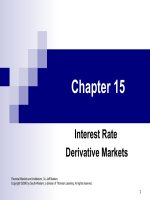Tài liệu Thị trường tài chính và các định chế tài chính_ Chapter 18 pdf
Bạn đang xem bản rút gọn của tài liệu. Xem và tải ngay bản đầy đủ của tài liệu tại đây (357.57 KB, 45 trang )
1
Chapter 18
Bank Regulation
Financial Markets and Institutions, 7e, Jeff Madura
Copyright ©2006 by South-Western, a division of Thomson Learning. All rights reserved.
2
Chapter Outline
Background
Regulatory structure
Deregulation Act of 1980
Garn-St Germain Act
Regulation of deposit insurance
Regulation of capital
Regulation of operations
Regulation of interstate expansion
How regulators monitor banks
The “too-big-to-fail” issue
Global bank regulations
3
Background
The banking industry has become more
competitive due to deregulation
Banks have more flexibility on the services they offer,
the locations where they operate, and the rates they
pay depositors
Banks have recognized the potential benefits from
economies of scale and scope
Bank regulation is needed to protect customers
who supply funds to the banking system
Regulators are shifting more of the burden of risk
assessment to the individual banks themselves
4
Regulatory Structure
The U.S. has a dual banking system consisting
of federal and state regulation
Three federal and fifty state agencies supervise the
banking system
A federal or state charter is required to open a
commercial bank
National versus state banks
Federal charters are issued by the Comptroller of the
Currency
State banks may decide to become members of the Fed
35 percent of all banks are members of the Fed, comprising
70 percent of deposits
5
Regulatory Structure (cont’d)
Regulatory overlap
National banks are regulated by the
Comptroller of the Currency, the Fed, and the
FDIC
State banks are regulated by the state
agency, the Fed, and the FDIC
Perhaps a single regulatory agency should be
assigned the role of regulating all commercial
banks and savings institutions
6
Regulatory Structure (cont’d)
Regulation of bank ownership
Commercial banks can be either
independently owned or owned by a bank
holding company
Most banks are owned by BHCs
BHCs have more potential for product diversification
because of amendments to the Bank Holding
Company Act of 1956
7
Deregulation Act of 1980
The Depository Institutions Deregulation and Monetary
Control Act (DIDMCA) was enacted in 1980
DIDMCA has two categories of provisions:
Those intended to deregulate the banking industry
Those intended to improve monetary control
The main deregulatory provisions are:
Phaseout of deposit rate ceilings
Allowance of NOW accounts for all depository institutions
New lending flexibility for depository institutions
Explicit pricing of Fed services
8
Deregulation Act of 1980 (cont’d)
DIDMCA also called for an increase in the
maximum deposit insurance level from $40,000
to $100,000 per depositor
Impact of DIDMCA
There has been a shift from conventional demand
deposits to NOW accounts
Consumers have shifted funds from conventional
passbook savings accounts to various types of CDs
DIDMCA has increased competition between
depository institutions
9
Garn-St Germain Act of 1982
The Act:
Permitted depository institutions to offer money market
deposit accounts (MMDAs), which have no interest
ceiling
MMDAs are similar to money market mutual funds
MMDAs allow depository institutions to compete against
money market funds in attracting savers’ funds
Permitted depository institutions to acquire failing
institutions across geographic boundaries
Intended to reduce the number of failures that require
liquidation
10
Regulation of Deposit Insurance
Federal deposit insurance has existed since the
creation of the FDIC in 1933 as a response to
bank runs
About 5,100 banks failed during the Great Depression
Deposit insurance has increased from $2,500 in 1933
to $100,000 today
Insured deposits make up 80 percent of all commercial
bank balances
The FDIC is managed by a board of five directors, who
are appointed by the President
11
Regulation of Deposit Insurance
(cont’d)
The FDIC’s Bank Insurance Fund is the pool of funds
used to cover insured deposits
The fund is supported with annual insurance premiums paid by
commercial banks, ranging from 23 cents to 31 cents per $100 of
deposit
In 2003, three BIF-insured banks failed with total assets of $1.1
billion
As of 2004, the BIF balance was about $34 billion
In 1991, the Federal Deposit Insurance Corporation
Improvement Act (FDICIA) was passed
Phased in risk-based deposit insurance premiums to counteract
the moral hazard problem
12
Regulation of Capital
Capital requirements force banks to
maintain a minimum amount of capital as a
percentage of total assets
Banks would prefer low capital to boost their
ROE
Regulators have argued that banks need
sufficient capital to absorb potential operating
losses
13
Regulation of Capital (cont’d)
Basel Accord of 1988
Central banks of 12 major countries agreed to uniform capital
requirements
The Accord was facilitated by the Bank for International
Settlements (BIS)
The key contribution of the Accord is that the requirements were
based on the bank’s risk level, forcing riskier banks to maintain a
higher level of capital
In 1996, the Accord was amended so that bank’s capital level also
account for its sensitivity to market conditions
Very safe assets are assigned a zero weight, while very risky
assets are assigned a 100 percent weight
14
Regulation of Capital (cont’d)
Basel II Accord
The Basel Committee has worked on an
accord that would refine the risk measures
and increase the transparency of a bank’s risk
to its customers
The three parts of the Accord are:
Revise the measurement of credit risk
Explicitly account for operational risk
Require more disclosure for market participants
15
Regulation of Capital (cont’d)
Basel II Accord (cont’d)
Revised measures of credit risk
The risk categories are being refined to account for some
possible differences in risk levels of loans within a category
A bank’s loans that are past due will have a weight of 150%
applied to their assets
Banks can use the internal ratings-based (IRB) approach to
calculate credit risk, in which banks provide summary statistics
about their loans to the Basel Committee
The Committee then applied pre-existing formulas to the
statistics in order to determine the required capital level
16
Regulation of Capital (cont’d)
Basel II Accord (cont’d)
Accounting for operational risk
Operational risk is the risk of losses from inadequate or failed
internal processes or systems
Intended to encourage banks to improve their techniques for
controlling operational risk to reduce bank failures
Initially, banks can use their own methods for assessing their
exposure to operational risk
The Basel Committee suggests the average annual income
generated over the last three years
17
Regulation of Capital (cont’d)
Basel II Accord (cont’d)
Public disclosure of risk indicators
The Basel Committee plans to require banks to
provide more information to existing and
prospective shareholders about their risk exposure
to different types of risk
This would provide existing and prospective
investors with additional information about a bank’s
risk
18
Regulation of Capital (cont’d)
Use of the value-at-risk method to determine
capital requirements
Under the 1996 amendment to the Basel Accord,
capital requirements on large banks were adjusted to
incorporate their own internal measurements of
general market risk
Market risk is the exposure to movements in market forces
such as interest rates, stock prices, and exchange rates
Capital requirements imposed are based on the bank’s own
assessment of risk when applying the VAR model
VAR is the estimated potential loss from trading businesses
that could result from adverse movements in market prices
Banks typically use a 99 percent confidence level









